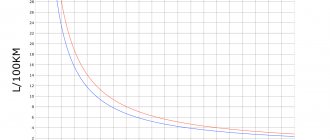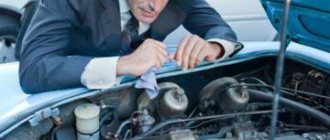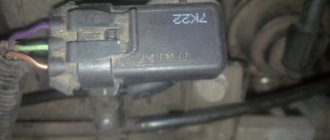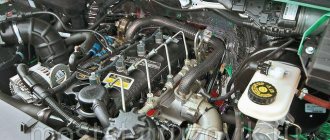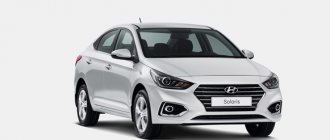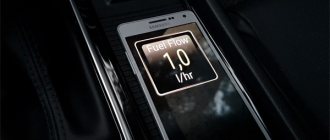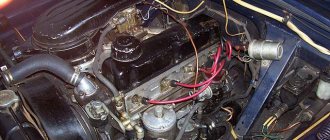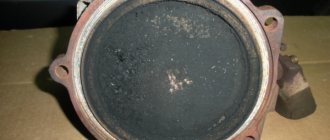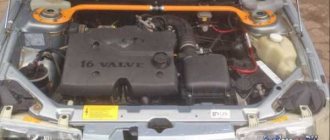m899ha › Blog › Myths and truth about fuel consumption.
MYTH1: “In a traffic jam it is better to turn off the engine” TRUTH: This is not entirely true. From the point of view of fuel economy, perhaps this only makes sense if the car is stuck in a traffic jam for more than 5-10 minutes. If you turn off and start the engine frequently, this, on the contrary, will lead to excessive fuel consumption and to some extent reduce the life of the engine and battery.
MYTH2: “Driving in neutral reduces gas consumption” TRUTH: Completely erroneous! In neutral, the engine consumes as much fuel as necessary to keep it idling. When releasing the gas or when braking the engine (gearbox), the electronics shuts off the fuel supply to the combustion chamber until the engine speed drops to idle speed. When the gear is switched off, the speed drops to idle, the gasoline supply is resumed and the savings end. Therefore, driving in gear and engine braking is more economical, more useful, and better from the point of view of traffic safety. By the way, the forced idling mode (moving in gear without pressing the accelerator) is very useful for the engine - fumes and soot are released.
MYTH3: “The wing reduces consumption” TRUTH: Just the opposite. A spoiler is needed to better press the car to the road. And it does this due to additional resistance to air flow (accordingly, additional fuel consumption). And the larger the area and angle of the spoiler, the more it affects consumption. There are spoilers that improve the aerodynamics of a car, but they are selected individually for each car with mandatory blowing in a wind tunnel. If there is a need to install a wing “for beauty”, it is better to choose a neutral spoiler, which does not have a pronounced angle of attack and is only an imitation of a sports accessory.
MYTH4: “You need to accelerate slowly to save fuel” TRUTH: Economical acceleration is smooth acceleration, not slow acceleration. Prolonged driving in low gears, on the contrary, leads to overspending. Of course, at the moment of acceleration, instantaneous consumption increases significantly, but the shorter the acceleration time, the faster the engine will reach optimal operating mode and reduce gasoline consumption.
MYTH5: “An engine that is warmed up in situ consumes less fuel” TRUTH: Indeed, an unheated engine consumes more fuel than a warmed one, but, firstly, warming up the engine at idle (in situ) entails increased fuel consumption, and all subsequent savings are lost into the pipe." Secondly, many car manufacturers simply do not recommend doing this in their owner's manuals. The fact is that an unheated engine emits much more harmful substances into the atmosphere. So it's better to start moving as quickly as possible.
MYTH6: “Driving in higher gears saves fuel” TRUTH: This is not entirely true. Driving at either too low or too high speeds will result in overshoot. The selected gear should correspond to the optimal engine speed. The optimal crankshaft rotation speed is different for each car and is approximately 80% of the rotation speed at which maximum power is achieved. For example, for an engine with a maximum torque of 4,000 rpm, the optimal speed is 3,200 rpm. Therefore, you should not neglect switching to a lower gear, because... driving in a higher gear at speeds close to idle - about 1,500 rpm - increases fuel consumption (the idle system begins to interfere with the mixture formation, adding excess fuel).
What increases the fuel consumption of a working car: - automatic transmission; — air conditioner on; — load on the generator (stereo system, headlights, additional energy consumers); — long warm-up, “traffic jams” on the roads Fuel consumption on a working car depends mainly on the driver himself - gasoline consumption increases significantly with sufficiently intense and frequent pressing of the gas pedal. Fuel consumption is also influenced by some environmental factors. For example, driving in the dark is less economical. And this is caused not only by the need to turn on the lights, but also by the need to use a different speed limit for safety reasons. The same can be said about driving in conditions of poor visibility - fog, rain, snow.
Road conditions can also have some impact on fuel consumption. Driving in icy conditions requires increased caution and reduced speed. In winter, fuel consumption is always higher than in summer. There are several reasons for this: installing winter tires, the need to warm up the engine for a longer time before driving, the use of heating devices, short daylight hours, quality of roads, etc. How to measure fuel consumption?
1. Fill the tank with fuel under the filler neck and note the odometer reading. 2. Drive as usual - pump out the fuel, and the greater the mileage, the more accurate the readings will be. 3. Return to the place of initial refueling and, using a measuring container (canister), refill the tank under the neck, write down the amount of gasoline filled. 4. By dividing the amount of fuel added by the mileage traveled by the car, we get the result. How to reduce fuel consumption?
A technically sound car will always consume less fuel than a car with faults. A uniform vehicle speed saves fuel, that is, sudden acceleration and braking are the enemies of economy. But don't neglect safety and move too slowly. In traffic, the safest option is to move at the speed of the flow. It's no secret that when driving around the city and on the highway, fuel consumption will be different. It will be different when driving on a country road and asphalt. Standing in traffic jams for a long time greatly increases fuel consumption, since the engine is running and the car is practically not moving. Therefore, when planning a trip, you need to think through the route in advance. Moreover, often a longer route does not mean less economical, and vice versa.
It is recommended to use the kinetic energy of the car - use the brake pedal as little as possible, coast more, brake and accelerate more smoothly, predict the situation on the road in advance (do not accelerate before a red traffic light). Do not warm up the engine to operating temperature while parked: as soon as the temperature gauge needle has moved, you can start driving. Vehicle malfunctions that increase fuel consumption:
— clogged air or fuel filters; — engine malfunction (one cylinder is not working, the timing belt is stretched, the ignition is set incorrectly); — malfunction of any sensor in the fuel injection system, etc.; - faulty suspension and transmission; — malfunction of the brake system; - low tire pressure.
Fuel consumption during engine warm-up and at the time of starting the power unit
Many drivers are concerned about the question of how to save fuel while operating a vehicle, especially taking into account the noticeable increase in the price of gasoline, diesel fuel and even gas. In some cases, you can hear from car enthusiasts that driving a car economically is not enough. The fact is that fuel is also consumed during the heating of the internal combustion engine.
At the same time, many have doubts whether such warming up of the engine before a trip is mandatory, as well as what the consumption during warming up is. In this article we will talk about what fuel consumption is when starting an engine, how much fuel a cold engine consumes before reaching operating temperatures and what nuances need to be taken into account
You can't help but warm
There is a common belief that modern car engines do not need to warm up before driving. It's a delusion. Warming up the engine is necessary; driving on a cold engine will not do any good.
“In the operational charts for all types of engines and at all times there is a clear indication: warming up the engine is necessary to achieve working clearances between parts and bring technical fluids to the specified viscosity values. The engine is made of different metals that have different thermal deformation rates. The engine design is designed for operation in a given temperature range, which is achieved by warming up the engine at idle,” says engineer Sergei Kolchin.
Operating the engine without warming it up can cause serious damage.
Fuel consumption when starting the engine
During a cold start, the engine requires a rich air-fuel mixture, that is, a mixture with a low air content and an increased gasoline content. In addition, after starting, the engine runs on a rich mixture for some time. This results in higher fuel consumption when starting the engine than during normal driving. This increase is not very noticeable with rare starts. However, if by chance you have to start it too often, then the consumption will be noticeable. For example, in traffic jams it is advisable to turn off the engine only if you have to stand for more than 5 minutes. After all, at the start, the same amount of fuel will be consumed as when the car is idle for 2-3 minutes. In addition, the battery will be subject to increased load, which is also not very good.
Video fuel consumption at startup
What is the REAL gas mileage when warming up at -20?
The purpose of the experiment is to find out how much gasoline a cold engine consumes, at -20 degrees Celsius, in the first 15 minutes until the speed stabilizes and the engine warms up. Since the main activity is Renault repair, we took the Renault Logan 2007 model year, 1.6 8V K7M engine as a basis. For other engines with cars of similar class, the differences will not be significant.
No duplicates found
Damn, now watch the video to find out 1 number? Be a person, write something for how much.
In short, with electrical appliances turned off except the stove (at speed 2), I ate 450 ml in 15 minutes.
I wonder what to do now with this information)
come to terms) For example, I was wondering how long it might take to warm up.
It takes me five minutes to warm up)
I agree, we interfere, but even at minus 20 there is a risk of splitting the windshield with a sharp stream of hot air if you turn on the stove after warming up.
I don’t have time to heat the car separately, the glass separately, the interior separately. Sorry)
You can direct the stove into the interior, not necessarily onto the glass. And also, if you direct air to the windshield while moving, then there is a strong tension there. Because the glass is blown with cold air from the outside. And it's hot inside. If the temperature is low, then you should direct air to the windshield only to prevent condensation from forming inside.
you can direct the heater (interior/window), then when the engine starts, gradually heating air will blow on the glass
You can send the stove to the salon
It is possible, but this is if you do not have the goal of warming up the glass.
And also, if you direct air to the windshield while moving, then there is a strong tension there. Because the glass is blown with cold air from the outside. And it's hot inside.
But we help warm up the interior.
Apparently to warm up the interior at least a little.
It’s faster and more economical to warm up the car first, and then turn on the heater. It turns out that when you heat it with cold air, the heater motor breaks down faster. In addition, the coolant is cooled and cold liquid enters the engine. I don’t presume to say that it’s like this everywhere, but it was like that on my car. The car with the heater on took longer to warm up and spent more fuel on warming up.
Fuel consumption when warming up the car
It is not recommended to warm up the engine at idle speed for more than 2-3 minutes. It is more economical and faster to warm up while driving at low speeds (somewhere up to 2-2.5 thousand). Fuel consumption during warming up increases and when warming up for more than 3 minutes, the fuel is simply burned in vain. In addition to savings from long-term heating on site, the environment also suffers. Since a poorly warmed-up engine is considered more toxic, many manufacturers categorically prohibit idling warming up the car. When warming up the car while driving, it is also better to avoid the “gas-brake” mode. Because by accelerating and immediately braking, we ourselves reluctantly increase fuel consumption. A simple calculation of the situation on the road in advance can help here. It is also better not to abuse driving at low speeds with a high gear engaged. This will affect fuel economy and reduce the service life of the engine, because it will operate in an uncomfortable mode. The normal engine speed range is between 2-3.5 thousand.
Fuel consumption when driving in neutral gear
A large number of drivers believe that driving in neutral is economical. They are very much mistaken. After all, fuel consumption at idle still continues so that the engine does not stall at idle speed. It is more advisable to simply stop pressing the accelerator pedal without changing gears. With this maneuver, the fuel stops flowing, and meanwhile the car continues to move by inertia. If the car is equipped with an automatic transmission, it is strictly forbidden to move the selector to mode N (neutral is used only for towing the car) or P (parking is intended for use before turning off the engine). These techniques will not save fuel, but the service life of the gearbox will be significantly reduced, and they are not cheap. Therefore, braking with the engine and driving without changing gears is more useful, more economical and safer. In addition, driving in gear without pressing the gas is very beneficial for the car, since at this moment combustion products are released from the cylinders. The number of power sources also greatly influences fuel consumption. Various electric heaters, powerful acoustic and audio systems, air conditioners and headlights during operation significantly increase the load on the generator, and in the meantime it additionally overloads the car engine.
Tips and tricks
Taking into account the above, it becomes clear that with frequent starts and subsequent warming up, consumption will inevitably increase. However, it is possible to reduce fuel consumption to one degree or another. To do this you need to do the following:
- It is better to warm up the engine, on average, for about 5 minutes (before the so-called “warm-up” speed drops);
- During warming up, if possible, do not turn on the headlights and side lights;
- the stove should be turned on to minimum;
- Unnecessarily, you should not use heated mirrors and windows, etc. or turn on such heating for a short time;
- after the speed drops, the engine needs to be further warmed up while driving;
- to avoid frequent cold starts, it is recommended to insulate the engine or install an autonomous pre-heater;
Note that warming up the engine while driving involves driving in lower gears. You need to drive at low speeds (2-2.5 thousand rpm). In this case, you should not actively brake the engine, and also avoid accelerating the car followed by active braking.
In other words, by first accelerating and then decelerating, harm is done to both the coldest engine and it also affects consumption, and in the direction of increase. For this reason, it is optimal to choose a route in such a way as to warm up the engine while driving on a flat road at a low speed, without traffic jams or traffic lights.
At the same time, the engaged gear will allow you to quickly accelerate and make a maneuver at any moment, which cannot be said about “neutral”. Also, with the gear engaged, the car is slowed down a little by the engine itself, the driver has a better chance of effectively coping with an unexpected skid, stopping the car faster, etc. It turns out that coasting without changing gears is more economical and safer than simply rolling in neutral.
As for cars with automatic transmission, it is important to understand that moving the selector to N (neutral) or P (park) while the car is moving is prohibited. This mode is used only for towing cars with an automatic transmission. You cannot save fuel in this way, but you can immediately damage the expensive automatic transmission.
Finally, we note once again that consumption is greatly influenced by both driving style and the number of energy sources (heaters, air conditioning, headlights, etc.). During their operation, the load on the generator increases, which leads to an increase in the load on the internal combustion engine itself and increased fuel consumption.
Fuel consumption: increased gasoline consumption
Introduction.
Information on fuel consumption will be useful to those who are concerned about this problem, but for those who are not considering the issue of efficiency it will be more useful to go to the Honda Civic tuning section. The fuel consumption of a Honda Civic, like any other car, depends on a whole system of factors. From driving style to fuel type. Let's try to analyze each of the parameters that influence increased gasoline consumption in a Honda Civic with a gasoline internal combustion engine.
An unpleasant feeling that gasoline is going to zero
formula for calculating fuel consumption per 100 km
The easiest way to measure is a simple formula:
Where in the calculation formula, L is the fuel filled in liters, S is the distance traveled, the amount of distance traveled divided by the amount of fuel filled, for example, they filled in 40, drove 456 km. 40: 4.56 = 8.77 liters of consumption per 100 km. I like the first formula for fuel consumption per 100 km. In conversations between people, in different magazines and reference books, there are different fuel consumption figures, even from the same type of car. One says that he drove 120 km on 10 liters of gasoline, another that on the highway it comes out to 6, the third complains about 18 liters in the city.
Correct engine operation
The first thing you need to pay attention to is the general condition of the engine. If you have a bad spark, that is, dirty or non-standard spark plugs, a spark breaks through high-voltage wires, a bad runner and distributor cap, then you know your fuel does not burn completely. A bad spark affects both power and gas mileage. No combustion, no power, usually drivers add even more acceleration to get at least some power out of the engine. At low speeds, the quality of the fuel-air ratio is monitored by a lambda probe - an oxygen sensor. If the mixture is lean at a certain speed, the sensor gives a signal to enrich the mixture next time. And vice versa. If the lambda probe does not work, the mixture will not be balanced. It’s worse if the sensor always shows one position. Then the mixture will either be richer or poorer. The power characteristics of the Civic also deteriorate and, accordingly, fuel consumption may increase. The correct ignition angle depends not only on the settings of the fuel maps, but also on the type of gasoline. If it is recommended to pour 95 gasoline into your car, this means that the ignition is configured for 95 type gasoline.
The nuances of warming up the car
Warming up a car engine depends on what it runs on: diesel or gasoline.
How to properly warm up a diesel car in winter? A diesel engine does not warm up when idling. To warm up, such an engine must move. The length of time spent on warming up will not increase the temperature in the engine or car interior.
The downside of warming up a diesel car this way is the accumulated soot on the filter and spoiled engine oil, which gets contaminated with fuel.
Auto center experts recommend that owners of cars with gasoline engines with a turbine warm up the car for no more than 1 minute. Gasoline engines with atmospheres do not need to be warmed up.
Hybrid models start in the same way as other engine types. If, when you turn on the “Start” button, the headlights come on and the engine starts, you don’t have to worry and go. Even in severe frosts, the operation of the oil system of such engines does not decrease; it takes a couple of seconds to warm up.
Warming up the engine of an electric car in winter is generally not worth it for owners. For a car like this, the colder the better. The main problem with an electric motor is overheating.
Should you warm up a car with a carburetor engine in winter? Necessarily! Otherwise, the engine cylinders may be damaged. A car that does not comply with Euro-2 should be warmed up to operating temperatures for about 20 minutes and only then start driving.
Cars of Euro-2 standard and higher, filled with high-quality fuel and oil, are warmed up for 1 minute, and then they begin to drive at low speed. Depending on the outside temperature, it will take 5-15 minutes to heat up such an engine.
Important!
Heat the glass in the car interior evenly, along with the interior. When getting into the car, do not turn the heating fan on full blast.
Fuel and lubricant consumption rates: warming up vehicles
Otherwise, combustion occurs at the wrong time, which also affects the power characteristics and, accordingly, fuel consumption may increase.
Another type of gasoline, transition from 95 to 92
The engine, as I said above, is tuned to a certain type of fuel; if you switch to a higher one, you will not only not add power, but you may also lose it; unburned fuel will burn out in the exhaust system, heating it and the engine itself as a whole. Candles will also become unusable faster. But even during the reverse transition from low to high, you waste engine life. The octane number of gasoline for an engine is determined by the compression ratio. The compression ratio is below 10, pour 92 gasoline, 10-12, pour 95 gasoline, above 98, etc. . With a high compression ratio and low octane number, the shock load increases. As a result, after saving a little on gasoline, you will have to fork out for engine repairs. In order to drive safely on both types of fuel, the car must have an ignition angle control system.
Warming up the engine
What is engine warming up in general and why is engine warming necessary? Warm-up is a time interval for minimal engine operation under light load (up to 2500-3000 RPM). The task of warming up is to allow the thickened oil to become more fluid, fill all engine channels with lubricant, and also cover the cylinder walls with an oil film so that the piston rings wear less (the service life of the rings is doubled!). That's it, purely technically, the warming up ends here. Warming up the interior, heating the glass, this is your personal desire.
Honda Civic starts perfectly even in Russian winter
Warming up the car in winter
Firstly, let's start with the fact that in winter, spring, and autumn it is a little more difficult to drive, and the consumption will be higher. This is due to air humidity and precipitation. Just like you, the car has to expend more energy, and therefore fuel, to overcome the path where there are puddles, snow, and dirt. This is the first reason why fuel consumption increases in winter. Further, for some reason, when calculating a car’s fuel consumption, engine warming up is not taken into account. In the summer you drove 100 km on 8 liters, and in the winter on 12 liters, taking into account that the engine is alive and working as it should. The answer is simple, you are overheating the car. The Honda Civic sits, warms up, time passes, the engine runs, fuel is consumed. It's simple. The most “difficult” thing for the engine is the first rotation of the crankshaft; if the oil is thin enough, then starting the engine will be easy; it is also recommended to depress the clutches on the mechanics to relieve the load on the gearbox. At first, the Honda Civic starts at 1500 RPM, and gradually increases to 750 RPM. Using the coolant temperature sensor and the idle air valve RACV or IACV to regulate RPM. Okay, started the car, 1500 rpm. According to the grandfather's method, when cars had very low efficiency, the oils were mainly mineral, then it was recommended to warm the car to an operating temperature of 60-70 degrees. The fathers were already heating less, about “one cigarette smoked,” during which time they usually drove the car out of the garage, cleaned the windows, and closed the garage. Now, even on our 1996-1998 Honda Civics, or on new cars, in winter, you can let the car run for about 10-40 seconds. During this time, the oil will fill all channels for engine operation, and the engine will reach the first minimum operating temperature. Further, at the same 1500 rpm, you can already move away, for the engine there is not much difference: it will idle at low speeds and consume fuel empty, or at these speeds it will turn the gearbox and move the car slowly along the route . It doesn't matter at all. Nobody says that you can press a slipper at -20 while warming up for 1 minute. You may just start moving at a lower speed. Well, we realized that in winter, due to atmospheric phenomena and initial heating, consumption increases. There is a problem that the engine cools down during the day, and you warm it up again with a “cigarette”. It is not surprising that the small Honda Civic engine consumes up to 20 liters, even on the highway, not to mention the city.
And in the heat and sand, VTEC!
Warming up the car in summer
In summer, the ambient temperature is at least 20 degrees, which means your engine is already warmed up to 20 degrees, that is, before operating at minimum speed. 10-15 seconds before starting is enough. Subsequent starts are made easier since the engine takes longer to cool down in the summer. It all comes down to reduced fuel consumption. There are living individuals who, foaming at the mouth, say that in the summer the engine must also be heated to 60-70 degrees before driving... I personally don’t understand this. Of course you have your own opinion on all this.
Riding style
If you start at each traffic light, leaving with trains faster than others, and immediately stopping after 400 meters, you again wait for the traffic light to clear, it is not surprising that your Honda Civic with a volume of 1.3 1.4 1.5 will consume up to 30 liters per 100 km. Do you want to save money in traffic jams in the city? Do not exceed rpm above 3000, there is no need to use the “pseudo-racing” driving mode. Yes, of course, this is a Honda, you just want to press the accelerator pedal on it, but if you know your city, then you should know on which sections of the roads you can do this, but carefully, and on which sections it is better to drive in traffic, with a pensioner neighbor. There is nothing terrible or shameful about this; you will still meet at the next traffic light.
Consumption in the city and outside the city
It is impossible to consider and discuss expenses in a city, especially if the people leading the discussion are in different cities. For example, St. Petersburg and Syzran. Different cities have different traffic conditions. If a person travels to the capital from the region to work, then most of the time in the morning and evening he will be stuck in traffic jams. A second person can travel the same route without traffic jams on the weekend easily and freely. As a result, the distance for both will be the same, the travel time of the first will tend to infinity, and at this time the engine is running. But the second one will have a minimum time to travel the route at a more constant speed, which means less fuel wasted. Measuring fuel consumption in the city cannot be a correct measurement method; compare conditions that are close to general ones, for example, measuring fuel consumption on the highway.
This article is relevant for Honda cars manufactured 1992-2000, such as Civic EJ9, Civic EK3, CIVIC EK2, CIVIC EK4 (partially). The information will be relevant for owners of Honda Integra in DB6, DC1 bodies, with ZC, D15B, D16A engines.
The VKontakte community can help you with most questions. It's really more convenient than writing comments below.
Summer and winter car trips are “two big differences.” One of the sides of this difference is the increased fuel consumption of a car in winter conditions. It's worth taking a closer look at the reasons for these extra costs and how you can reduce unwanted fuel costs.
You can’t warm up the engine “by temperature”
Traditionally, Russian drivers control the warming up of a car engine using the temperature sensor readings. Most modern internal combustion engines have an operating temperature of 90 degrees. But this approach is wrong. For a car enthusiast, it can result in excessive fuel consumption for warming up and a significant loss of time.
“You can warm up the car at idle to 90 degrees at a temperature of minus 20. But this will take 30-40 minutes. It’s not practical to waste fuel and time on such warming up,” says auto mechanic Vitaly Loginov .
Engine oil thickens at low temperatures. Mineral loses viscosity at a temperature of 15-20 degrees below zero, “semi-synthetic” at 25-30 degrees below zero. Thick oil negatively affects the operation of an internal combustion engine.
“The oil in the engine performs three functions at once: lubrication of rubbing surfaces, removal of wear products and cooling of moving parts. In case of negative temperatures, the last two points are not relevant. There is no need to cool a cold engine, and wear in this mode is negligible. But the engine doesn’t have enough lubrication, and because of this, the friction force increases,” says Vitaly Loginov.
High friction forces lead to high fuel consumption. Almost all modern cars have on-board computers that display fuel consumption indicators. Vitaly Loginov advises heating the car “according to consumption”.
“A car with an engine power of up to 100 horsepower at idle consumes 0.8-0.9 liters of fuel per hour. When starting a cold engine, this figure is usually 2.7-3 liters per hour. To get the engine into operating mode, it is enough to warm it up to normal levels. Waiting for it to warm up to 90 degrees is a waste of time and gasoline,” says Vitaly Loginov.
Reasons for increased fuel consumption in winter
Warming up the engine and lubrication system
In winter, it takes longer for the engine to reach operating temperature. Additional idling time results in increased fuel consumption. This is especially true for cars with carburetor engines. The desire to save fuel and start moving without waiting for the temperature to rise to operating values leads to the fact that the engine will “sneeze” and the car will move jerkily.
In winter, the engine takes longer to warm up than in summer. This also increases fuel consumption
Modern cars do not require prolonged engine warm-up. It only needs to idle for no more than one minute - and you can start moving. But you still have to spend a minute, and there will be additional fuel consumption.
If the machine is used occasionally in winter, then losses specifically on heating will not have a significant effect. But for cars used daily, the extra fuel to warm up the engine twice a day (before going to work, and before returning from work) is a fairly significant increase in overall costs.
And it’s not just the engine that needs to be warmed up. The oil in the transmission and the grease in the bearings become thicker in the cold, and it takes time to warm them up and reach operating conditions. And during this time you will have to overcome additional resistance and spend additional fuel on this.
According to various estimates, additional fuel consumption for warming up the engine and all systems can reach 5–10%
Of course, these are average values - the exact losses depend on weather conditions and the make of the car.
Deteriorating road conditions
Driving on winter roads requires additional effort from the car, which requires additional fuel. Here are the main reasons that worsen car driving in winter:
- The grip of tires on the road in winter conditions is worse than in summer. Even on compacted snow it is more difficult to move than on asphalt. This is when moving without any special obstacles. But additional problems are created by slipping in slippery areas, especially when starting from a stop. But you also have to drive immediately after a snowfall, when the snow has not yet been compacted. Increased gasoline consumption during difficult driving is obvious.
- Getting into snowdrifts or drifts causes the engine to operate at higher speeds. And leaving a parked car after heavy snowfall is a whole different story. Just to get out of a parking snowdrift, sometimes you have to spend as much fuel as a trip of average duration
- When driving on winter country roads, you must be careful and drive at a reduced speed (compared to summer conditions). Therefore, it is not always possible to maintain the most economical driving mode.
- Traffic jams. They, of course, occur in the summer, and statistics say that in the summer there are even more of them. But in winter they are larger. Due to snowdrifts after snowfall, many roads can only be driven in one lane in each direction. And any accident often leads not to a restriction, but to a virtual cessation of traffic on this road.
Driving in difficult winter weather conditions also causes an increase in vehicle fuel consumption
Increased energy consumption
Few people dare to drive in winter without the heater on. In decent frosts, the interior heater has to constantly work at full power. In addition to the interior, you have to separately heat the rear windows and mirrors. And there’s no escape – it’s already a matter of safety. And the energy for the operation of all heaters is provided by the engine, spending extra liters of gasoline on this.
Heating the vehicle's interior, windows and mirrors also increases fuel consumption
Starting an engine in cold weather is often not as quick and easy as in warm weather. As a result, the battery discharges more strongly after a winter start. And at subzero temperatures, even a disconnected battery holds less charge than in a warm environment. And the generator needs to work longer to restore the battery’s nominal charge, which also consumes fuel.
Little things
- Aerodynamic resistance. Cold air increases resistance to vehicle movement. Therefore, in winter, even when driving at optimal speeds, fuel consumption is higher. Under certain conditions, this is not a small thing. In severe frosts (-40 or more), just because of this factor, you can use 10% more gasoline than in summer temperatures of +20.
- Tire pressure. As the temperature drops, the tire pressure also decreases. The dependence is approximately 0.1 atmosphere for every 10 degrees of temperature. Abnormally low pressure not only causes tire wear, but also increases fuel consumption.
- In carburetor engines, with constant adjustments at low air temperatures, the fuel-air mixture changes its characteristics, which affects engine operation and leads to increased fuel consumption.
It will not be possible to achieve the same fuel consumption in summer and winter - the conditions are too different. And in winter, the car will still consume more gasoline. For example, the official website of the Ministry of Transport of the Russian Federation regulates an increase in winter fuel consumption standards by 5 - 20%. Moreover, a 5% increase is set for the southern regions, but for the northern regions, where the influence of winter is much higher, a 20% increase is recommended.
But this difference can be reduced by knowing the reasons for its occurrence and, if possible, reducing their influence.
Warm-up features
The engine will be fully warmed up as soon as all the working fluids reach the operating temperature, i.e. they stop heating further. Antifreeze reaches temperature faster than others. With it, the upper elements of the engine - the head and pistons - begin to thaw.
But with oil in the pan the situation is completely different: it heats up much more slowly. How to see it? Anyone who pays attention to the on-board computer can notice that even after the coolant is fully heated, fuel consumption at idle may decrease. Therein lies the answer: the problem is unheated oil. The neutralizer takes the longest to gain heat. After this, the toxicity of the gases returns to its usual level. The warm-up speed is greatly influenced by the operating mode of the motor.
Ways to reduce fuel consumption in winter
Engine
- Reducing the engine warm-up time at idle is a big contribution to saving gasoline. It is best to start driving immediately after reaching the minimum temperature that does not interfere with normal engine operation. When driving in low gears, the engine will warm up to operating temperature faster. And all lubrication units will also warm up faster while driving. But you can’t completely abandon warming up. It will be possible to achieve fuel savings, but the damage to the engine itself may be such that the savings will be negative. We need to look for a middle ground. When choosing an idle warm-up time, it is better to focus on the recommendations of the car manufacturer, as well as your own experience and the feel of your car. The best solution is to keep the car in a warm garage. At least the morning departure will take place without prolonged warm-up.
To save fuel in winter, it is recommended to warm up the car to a minimum temperature that does not interfere with normal engine operation.
Insulating the engine compartment will also help save fuel
- Changing tires for winter conditions is more of a safety issue. Savings are secondary here, but they are also present. Yes, tires with winter tread are less economical than summer tires. But this is in equal conditions, and when driving on a good road. In winter, conditions are far from equal to those in summer, and the quality of the road is often much worse. This is where winter tires cover all their “disadvantages” and ultimately help save a lot of fuel. Driving on freshly fallen snow, reducing slippage, overcoming snowdrifts - this is where the superiority of winter tires is undeniable.
- It is important to remember to reduce tire pressure as temperatures drop. Do not increase the pressure to values outside the normal range. In winter, it is better to monitor this parameter more often.
Energy consumption
It is not worth saving on heating the interior and rear window in winter. The work of these energy consumers is a severe necessity that cannot be avoided. But it is recommended to limit the inclusion of other energy consumers - for example, a sound system. Especially until the engine is fully warmed up and the battery is charged after starting.
To reduce fuel consumption, it is recommended to limit the energy consumption of systems that are not responsible for heating and safety, for example, sound.
Driving Character
Driving a car in winter is different from driving in summer. There is a lot of advice on this topic, but now we are only talking about saving fuel.
- A sudden start from a standstill must be avoided. The car may simply remain in place, skidding on inopportunely turned up ice.
- It is advisable to take a more responsible approach to choosing a route, avoiding traffic jams. Winter traffic jams are larger, so it’s better not to risk it, hoping that it will resolve soon.
- Pay close attention to the condition of the road, avoiding areas where the car may get stuck or skid.
- Don't park in the first place you come across. A small snowdrift or patch of ice can make it very difficult to get out.
- Fallen snow must be cleared not only from the car windows, but also from the roof and trunk. Excess weight means extra load on the machine.
- It’s worth considering whether a roof rack is needed in winter. On long trips, it “steals” fuel in the summer, and in winter this consumption increases.
- It is useful to inspect the trunk before the winter season. If possible, remove heavy and not very necessary items from it. A trifle, but it will be easier for the car. You don’t need to put the shovel away, but on the contrary, put it in the trunk and carry it around all winter. If you don’t need it, that’s good. But sometimes just a few swipes of a shovel can provide the car with a trouble-free exit from the problem area.
Most tips for reducing unwanted fuel consumption boil down to one thing: it’s difficult for a car in winter, and any help in its difficult work is welcome. Help your car even in small things - and it will thank you. Including a slight increase in fuel costs.
Winter has come and now many cars “start” according to the alarm time (banal programmable autostart). Also, many write that it is precisely because of such “warming up” that a large amount of fuel is wasted. That is, the consumption at idle is simply huge (increases by almost 50%)! BUT is this really so? How much does the car consume per hour with such idle warm-ups? Let's find out + as usual video version...
Of course, the colder it is, the more difficult it is for the car to start and operate for the first 3–5 minutes; then the system warms up and consumption drops. But it becomes clear that in any case there is a cost, but not as huge as many people write.
RESISTANCE TO MOTION
Why doesn't the engine like frost? The main reason is that any motor oil thickens in the cold. And at certain temperatures it may stop flowing altogether. Mineral oils - already at minus 20...25 °C, the best synthetics - at minus 45...55 °C. As a result, the friction units run dry, and the power of mechanical losses increases sharply, which requires extra gasoline. But when will the motor quickly reach the normal level of mechanical losses? Should I stand and warm myself or if I go on the road immediately after starting? This will answer the question of savings - after all, extra losses require additional fuel.
Let's check how much fuel a regular injection engine consumes with the same mileage but different warm-up algorithms. A little about the patient. A pure “European” produced in 2005, 1.6 liters of displacement, declared as Euro-4. He spent his entire adult life in Russia, but apart from maintenance, nothing was done to it. So, three warm-up programs. The first option is the “old-fashioned” one: fully warm up the engine and only then drive. The second is according to the instructions of modern cars: “let it go and go.” And the third is the one that can most often be found: we started up, brushed off the snow, waved a shovel (in general, we wasted time), and we warmed up the car already on the trip. Outside - minus 15. The battery is good, the tray contains expensive synthetics. Mileage - from the parking lot to work: this is about 5 kilometers, and without traffic jams! You can dream...
So, option 1. Let's go. The tachometer needle is set to o, the computer shows instantaneous fuel consumption of 2.5 l/h. After a minute, consumption drops to 1.9 liters, after 10 minutes - to 0.9 liters. Then the visible changes on the on-board computer end - the arrow on the temperature indicator does not even reach 50 degrees and stands rigid. To be safe, we wait another 10 minutes - fuel consumption decreases to 0.8 l/h, which is still more than the usual 0.6 observed when the entire engine is fully warmed up. You can't achieve a better result - let's go! We are driving in fixed mode, third gear, 50 km/h, there are no traffic lights along the road. Consumption according to the computer is 6.4...6.6 l/100 km. In total, we spent 0.45 liters on warming up, and about 0.33 liters on the road. Total - about 0.8 liters.
Option 2 - got in, started up and immediately drove off. The car didn’t like this very much, and to begin with it produced a consumption of more than 10 liters. Then it began to quickly decline, but due to the short drive it never reached the previous 6.5 - it stopped at 6.8 liters. In total, only 0.45 liters were used. Plus saving 20 minutes of precious time. There seems to be savings, but they seem impressive only on short runs.
Option 3 - after starting, we warmed the engine for 5 minutes while the ice was scraped off the windows. We started with an idle consumption of 1.3 l/h. The beginning of the run was marked by the figure 7.6 l/100 km, by the end of the race they returned to 6.6. Total, taking into account mileage - 0.55 liters. Better than the first option, but slightly worse than the second.
About the alarm
Alarm system with auto start, allows you to start the car for 5 - 10 minutes. Moreover, usually the default is 10 minutes, but you can set it to 5, on some alarms it’s 3 minutes.
You can set it to run automatically by time, for example:
- Will start before you arrive
- Or by time interval (every 2 hours),
- By temperature (warmed up - stopped - cooled down - started again).
- Well, of course, you can start it yourself from the window in the morning (this is if the car is parked in front of the windows).
The most common are points 1 and 4, and basically no one removes the factory settings; the machine “keeps on” for 10 minutes. (it is during this time that we will calculate fuel consumption below)
How much does it cost per hour?
We came to the most interesting part – measurements. It can take a long time to calculate consumption using formulas. BUT we will do it easier, we have an excellent diagnostic adapter for the ELM327 car (which is installed in the OBD2 connector). Still, now modern “injection” cars are a bit like computers.
Next, install the TORQUE program on your phone; it has a bunch of tools that allow us to read certain readings through the car’s sensors.
Well, of course, we have a plugin - “instant fuel consumption”, it is calculated in “liters per hour”.
I won’t tell you in detail how to connect it to the car (all this will be in the video version). I will also measure the average consumption per hour in my car – KIA OPTIMA 2.0 liters.
So, what happens - while the car is not warmed up, the consumption fluctuates between 1.0 - 1.2 liters per hour (it was about -10 degrees Celsius outside). After 2 - 3 minutes, the system warmed up, the flow rate dropped to 0.7 - 0.8 liters per hour
I also conducted experiments on cars with a smaller engine capacity, 1.4 - 1.6 liters. Their fuel consumption on a warm engine is approximately 0.6 - 0.7 liters, and on a cold engine they will also consume about 1 liter. at one o'clock. I think that this fuel consumption algorithm is regulated by the ECU; after the system warms up to at least +20, +30 degrees, the control unit automatically reduces the fuel supply and the speed drops.
Of course, the lower the temperature outside, the longer the interval at higher speeds with a consumption of 1 liter per hour will be. For example, at -20, -30 degrees it will be approximately 5 - 7 minutes.
How much does it cost to warm up the engine in winter?
Fuel economy today worries drivers more and more, ever since gasoline prices began to rise and promise to only increase in 2019. How to reduce fuel consumption in winter? It won't work if you don't heat it. Let's look at how much fuel the engine consumes when starting the engine.
When you turn on a cold engine, it requires a rich mixture of gasoline and air. The unit will rattle on it until it reaches operating temperature. Motorists have probably noticed that as soon as you start a cold engine, the idle speed is increased. Then they decrease, which means the engine temperature rises. It is quite obvious that when starting a cold engine, fuel consumption is greater than if you turned off the engine, left for a while, and then came back and started it again. But in any case, the moment the engine starts, the consumption increases.
If you drive around the city and often turn off and start the engine, fuel consumption increases significantly. Therefore, if you stop for 5 minutes or are stuck in a traffic jam, it is better not to turn off the engine. Of course, if you need to stop for a longer period, then it is better to turn off the car. It is estimated that when starting, the engine will spend the same amount of gasoline as when idling for 3-5 minutes.
No matter how much the engine eats during warm-up, in winter it still needs to be warmed up. This is due to difficult conditions in which the car has to drive, often slip, drive in low gears, and waste energy on warming up various systems that are inactive in the summer. According to experts, in winter the “gluttony” of a car increases by 20-30 percent. So warming up is not the only culprit for increased consumption in winter.
According to estimates, fuel consumption when idling on a gasoline engine is from 1.4 to 2 liters in volume, leaving an average of a liter per hour in winter. And it doesn’t matter what kind of gearbox the car has. In summer it drops to 0.8 liters, but with climate control and air conditioning it grows to 1.5-2 liters. But the stove consumes less than the air conditioner. But if, when starting the engine, you turned on the heater at full, heated seats and mirrors, headlights, then the consumption will increase to 1.8 - 2 liters.
Thus, on average, in 15 minutes of warming up in winter, the car will use a quarter of a liter. Of course, if you often turn off the engine and start it, the higher the total consumption will be. But you can’t get by without warming up in winter.
So how much does autostart consume?
It's not difficult to calculate here. We will take the standard case of “10” minutes before work, and “10” after the working day (why “10”, because rarely will anyone change the standard alarm settings for 5 minutes or less).
I will also take the flow rate at -10 degrees. Let me remind you that for the first 3 minutes it is 1 l/h
At -20 deg. 5 minutes. – 1l/h
At -30 deg. 7 min. – 1l/h
It turns out (3+3=6min.)-1l/h, then (7+7=14min.)-0.7l/h
We have 60 minutes in an hour:
Then – 1000ml/60 = 16.6ml/min *6 = 100ml
Next – 700ml/60 = 11.7ml/min *14 = 163ml
As a result, at -10 degrees. Celsius (2.0 liter engine) - for two starts of 10 minutes each, consumes - 100 + 163 ml = 263 ml. OR ALMOST - 0.3 liters. It's up to you to decide whether it's a lot or a little.
Of course, a car with a smaller engine will spend a little less at idle. If we go the logical route, then let’s say the 1.6 liter engine is 20% smaller in volume than the 2.0 version. This means that it will consume 20% less at idle.
263ml – 20% = 210 ml.
Of course, if your engine volume is larger and the temperature is lower, then everything can be calculated for your conditions. As you can see, all this is quite simple.
Well, before concluding the article, I would like to say that fuel consumption in winter is affected not only by idling (of the engine), but also by a bunch of other parameters. For example, winter tires, oil thickness, snow on the roads, etc. Watch all about this in my video, I recommend it to everyone.
This is where I end, I think my article and video were useful to you. Sincerely yours, AUTOBLOGGER
(17 votes, average: 4.06 out of 5)
How to identify the causes of engine tripping
Next, we will consider the procedure for finding and eliminating the cause of the engine tripping when cold without the use of special tools.
- We determine which cylinder is not working.
- We inspect the spark plugs and check their functionality.
- Checking the high voltage wires.
- We check the serviceability of the distributor and ignition coil.
- Checking the vacuum brake booster.
- We replace the faulty part with a new one.
Video: Trouble on cold. 16V. Repair of VAZ 2110
Almost every car enthusiast sooner or later encounters such a fairly common malfunction of the internal combustion engine, when the engine stalls. As a rule, in certain situations the engine stalls when hot or only when cold, and tripping can also occur constantly (regardless of the temperature of the power unit, operating mode, load level, etc.).
